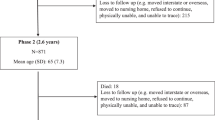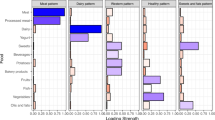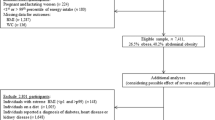Abstract
Background/objectives
To identify predictors of obesity in adults and investigate to what extent these predictors are independent of other major confounding factors.
Subjects/methods
Data collected at baseline from 1441 participants from the Food4Me study conducted in seven European countries were included in this study. A food frequency questionnaire was used to measure dietary intake. Accelerometers were used to assess physical activity levels (PA), whereas participants self-reported their body weight, height and waist circumference via the internet.
Results
The main factors associated (p < 0.05) with higher BMI per 1-SD increase in the exposure were age (β:1.11 kg/m2), intakes of processed meat (β:1.04 kg/m2), red meat (β:1.02 kg/m2), saturated fat (β:0.84 kg/m2), monounsaturated fat (β:0.80 kg/m2), protein (β:0.74 kg/m2), total energy intake (β:0.50 kg/m2), olive oil (β:0.36 kg/m2), sugar sweetened carbonated drinks (β:0.33 kg/m2) and sedentary time (β:0.73 kg/m2). In contrast, the main factors associated with lower BMI per 1-SD increase in the exposure were PA (β:−1.36 kg/m2), intakes of wholegrains (β:−1.05 kg/m2), fibre (β:−1.02 kg/m2), fruits and vegetables (β:−0.52 kg/m2), nuts (β:−0.52 kg/m2), polyunsaturated fat (β:−0.50 kg/m2), Healthy Eating Index (β:−0.42 kg/m2), Mediterranean diet score (β:−0.40 kg/m2), oily fish (β:−0.31 kg/m2), dairy (β:−0.31 kg/m2) and fruit juice (β:−0.25 kg/m2).
Conclusions
These findings are important for public health and suggest that promotion of increased PA, reducing sedentary behaviours and improving the overall quality of dietary patterns are important strategies for addressing the existing obesity epidemic and associated disease burden.
This is a preview of subscription content, access via your institution
Access options
Subscribe to this journal
Receive 12 print issues and online access
$259.00 per year
only $21.58 per issue
Buy this article
- Purchase on SpringerLink
- Instant access to full article PDF
Prices may be subject to local taxes which are calculated during checkout



Similar content being viewed by others
References
Afshin A, Forouzanfar MH, Reitsma MB, Sur P, Estep K, Lee A, et al. Health effects of overweight and obesity in 195 countries over 25 years. New Eng J Med. 2017;377(1):13–27. https://doi.org/10.1056/NEJMoa1614362
Collaboration NRF. Trends in adult body-mass index in 200 countries from 1975 to 2014: a pooled analysis of 1698 population-based measurement studies with 19.2 million participants. Lancet. 2016;387(10026):1377–96. https://doi.org/10.1016/S0140-6736(16)30054-X
Hill JO. Understanding and addressing the epidemic of obesity: An energy balance perspective. Endocr Rev. 2006;27(7):750–61. https://doi.org/10.1210/er.2006-0032
Bouchard C. Gene-environment interactions in the etiology of obesity: defining the fundamentals. Obesity. 2008;16:S5–S10. https://doi.org/10.1038/oby.2008.528
WHO. Global health risks: mortality and burden of disease attributable to selected major risks. Geneva, Switzerland: World Health Organization; 2009.
Celis-Morales C, Livingstone KM, Marsaux CFM, Forster H, O’Donovan CB, Woolhead C, et al. Design and baseline characteristics of the Food4Me study: a web-based randomised controlled trial of personalised nutrition in seven European countries. Gene Nutr. 2015;10(1). https://doi.org/10.1007/s12263-014-0450-2
Celis-Morales C, Livingstone KM, Marsaux CFM, Macready AL, Fallaize R, O’Donovan CB, et al. Effect of personalized nutrition on health-related behaviour change: evidence from the Food4me European randomized controlled trial. Int J Epidemiol. 2016. https://doi.org/10.1093/ije/dyw186
WHO. Obesity: preventing and managing the global epidemic. Report of a WHO consultation. 2000. Report No. 0512-3054.
Celis-Morales C, Livingstone KM, Woolhead C, Forster H, O’Donovan CB, Macready AL, et al. How reliable is internet-based self-reported identity, socio-demographic and obesity measures in European adults? Gene Nutr. 2015;10(5):476–476. https://doi.org/10.1007/s12263-015-0476-0
European Commission. European skills, competences, qualifications and occupations. 2015.
Marsaux CFM, Celis-Morales C, Hoonhout J, Claassen A, Goris A, Forster H, et al. Objectively measured physical activity in European adults: cross-sectional findings from the food4me study. PLoS ONE 2016;11(3). https://doi.org/10.1371/journal.pone.0150902
Forster HFR, Gallagher C, O’Donovan CB, Woolhead C, Walsh MC, Macready AL, Lovegrove JA, Mathers JC, Gibney MJ, Brennan L, Gibney ER. Online dietary intake estimation: the food4me food frequency questionnaire. J Med Internet Res. 2014;16(6):e150.
Fallaize R, Forster H, Macready AL, Walsh MC, Mathers JC, Brennan L, et al. Online dietary intake estimation: reproducibility and validity of the Food4Me food frequency questionnaire against a 4-day weighed food record. J Med Internet Res. 2014;16(8):e190. https://doi.org/10.2196/jmir.3355
Fallaize R, Forster H, Macready AL, Walsh MC, Mathers JC, Brennan L, et al. Online dietary intake estimation: reproducibility and validity of the Food4Me food frequency questionnaire against a 4-day weighed food record. J Med Internet Res. 2014;16(8). https://doi.org/10.2196/jmir.3355
Forster H, Fallaize R, Gallagher C, O’Donovan CB, Woolhead C, Walsh MC, et al. Online dietary intake estimation: the Food4Me food frequency questionnaire. J Med Internet Res. 2014;16(6):e150–e150. https://doi.org/10.2196/jmir.3105
Food Standards Agency. McCance and Widdowson’s The Composition of Foods, Sixth summary edition edn Royal Society of Public Health England, Chemistry: Cambridge, 2002.
Celis-Morales C, Livingstone KM, Marsaux CFM, Forster H, O’Donovan CB, Woolhead C, et al. Design and baseline characteristics of the Food4Me study: a web-based randomised controlled trial of personalised nutrition in seven European countries. Genes Nutr. 2015;10(1):450. https://doi.org/10.1007/s12263-014-0450-2
Martínez-González MÁ, Corella D, Salas-Salvadó J, Ros E, Covas MI, Fiol M, et al. Cohort profile: design and methods of the PREDIMED study. Int J Epidemiol. 2012;41(2):377–85. https://doi.org/10.1093/ije/dyq250
Guenther PM, Kirkpatrick SI, Reedy J, Krebs-Smith SM, Buckman DW, Dodd KW, et al. The healthy eating index-2010 is a valid and reliable measure of diet quality according to the 2010 dietary guidelines for Americans. J Nutr. 2014;144(3):399–407. https://doi.org/10.3945/jn.113.183079
Livingstone KM, Celis-Morales C, Macready AL, Fallaize R, Forster H, Woolhead C et al. Characteristics of European adults who dropped out from the Food4Me Internet-based personalised nutrition intervention. Publ Health Nutr. 2016;1–11. https://doi.org/10.1017/S1368980016002020
Saris WHM, Blair SN, van Baak MA, Eaton SB, Davies PSW, Di Pietro L, et al. How much physical activity is enough to prevent unhealthy weight gain? Outcome of the IASO 1st Stock Conference and consensus statement. Obes Rev: J Int Assoc Study Obes. 2003;4(2):101–14. https://doi.org/10.1046/j.1467-789X.2003.00101.x
Erlichman J, Kerbey AL, James WPT. Physical activity and its impact on health outcomes. Paper 2: Prevention of unhealthy weight gain and obesity by physical activity: an analysis of the evidence. Obes Rev Offic J Int Assoc Study Obes. 2002;3(4):273–87. https://doi.org/10.1046/j.1467-789X.2002.00078.x
Thorp AA, Owen N, Neuhaus M, Dunstan DW. Sedentary behaviors and subsequent health outcomes in adults A systematic review of longitudinal studies, 1996–2011. Am J Prev Med. 2011;41(2):207–215. https://doi.org/10.1016/j.amepre.2011.05.004
Togo P, Osler M, Sorensen T, Heitmann B. Food intake patterns and body mass index in observational studies. Int J Obes. 2001;25(12):1741–51. https://doi.org/10.1038/sj.ijo.0801819
Rouhani MH, Salehi-Abargouei A, Surkan PJ, Azadbakht L. Is there a relationship between red or processed meat intake and obesity? A systematic review and meta-analysis of observational studies. Obes Rev. 2014;15(9):740–48. https://doi.org/10.1111/obr.12172
Hooper L, Abdelhamid A, Bunn D, Brown T, Summerbell CD, Skeaff CM. Effects of total fat intake on body weight. Cochrane database of systematic reviews. 2015;8. https://doi.org/10.1002/14651858.CD011834
Hooper L, Martin N, Abdelhamid A, Davey Smith G. Reduction in saturated fat intake for cardiovascular disease. Cochrane database of systematic reviews. 2015;6. https://doi.org/10.1002/14651858.CD011737
Ludwig DS, Pereira MA, Kroenke CH, Hilner JE, Van Horn L, Slattery ML, et al. Dietary fiber, weight gain, and cardiovascular disease risk factors in young adults. J Am Med Assoc. 1999;282(16):1539–46. https://doi.org/10.1001/jama.282.16.1539
McKeown NM, Yoshida M, Shea MK, Jacques PF, Lichtenstein AH, Rogers G, et al. Whole-grain intake and cereal fiber are associated with lower abdominal adiposity in older adults. J Nutr. 2009;139(10):1950–55. https://doi.org/10.3945/jn.108.103762
Schwingshackl L, Hoffmann G, Kalle-Uhlmann T, Arregui M, Buijsse B, Boeing H. Fruit and vegetable consumption and changes in anthropometric variables in adult populations: a systematic review and meta-analysis of prospective cohort studies. PLoS ONE 2015;10(10). https://doi.org/10.1371/journal.pone.0140846
Anderson J, Celis-Morales C, Mackay D, Iliodromiti S, Lyall D, Sattar N, et al. Adiposity among 132 479 UK Biobank participants; contribution of sugar intake vs other macronutrients. Int J Epidemiol. 2016. https://doi.org/10.1093/ije/dyw173
Malik VS, Pan A, Willett WC, Hu FB. Sugar-sweetened beverages and weight gain in children and adults: a systematic review and meta-analysis. Am J Clin Nutr. 2013;98(4):1084–102. https://doi.org/10.3945/ajcn.113.058362
Kuhnle GGC, Tasevska N, Lentjes MAH, Griffin JL, Sims MA, Richardson L, et al. Association between sucrose intake and risk of overweight and obesity in a prospective sub-cohort of the European Prospective Investigation into Cancer in Norfolk (EPIC-Norfolk). Publ Health Nutr. 2015;18(15):2815–24. https://doi.org/10.1017/s1368980015000300
Scientific Advisory Committee on Nutrition. Carbohydrates Health. London: The Stationery Office; 2015.
Lassale C, Fezeu L, Andreeva VA, Hercberg S, Kengne AP, Czernichow S, et al. Association between dietary scores and 13-year weight change and obesity risk in a French prospective cohort. Int J Obes. 2012;36(11):1455–62. https://doi.org/10.1038/ijo.2011.264
Mozaffarian D, Hao T, Rimm EB, Willett WC, Hu FB. Changes in diet and lifestyle and long-term weight gain in women and men. Engl J Med. 2011;364(25):2392–404.
Sanchez-Villegas A, Bes-Rastrollo M, Martinez-Gonzalez MA, Serra-Majem L. Adherence to a Mediterranean dietary pattern and weight gain in a follow-up study: the SUN cohort. Int J Obes. 2006;30(2):350–58. https://doi.org/10.1038/sj.ijo.0803118
Romaguera D, Norat T, Vergnaud A-C, Mouw T, May AM, Agudo A, et al. Mediterranean dietary patterns and prospective weight change in participants of the EPIC-PANACEA project. Am J Clin Nutr. 2010;92(4):912–21. https://doi.org/10.3945/ajcn.2010.29482
Schroder H, Marrugat J, Vila J, Covas MI, Elosua R. Adherence to the traditional Mediterranean diet is inversely associated with body mass index and obesity in a Spanish population. J Nutr. 2004;134(12):3355–61.
Panagiotakos DB, Chrysohoou C, Pitsavos C, Stefanadis C. Association between the prevalence of obesity and adherence to the mediterranean diet: the ATTICA study. Nutrition. 2006;22(5):449–56. https://doi.org/10.1016/j.nut.2005.11.004
Romaguera D, Norat T, Mouw T, May AM, Bamia C, Slimani N, et al. Adherence to the mediterranean diet is associated with lower abdominal adiposity in European men and women. J Nutr. 2009;139(9):1728–37. https://doi.org/10.3945/jn.109.108902
Serra-Majem L, Roman B, Estruch R. Scientific evidence of interventions using the Mediterranean diet: a systematic review. Nutr Rev. 2006;64(2):S27–S47. https://doi.org/10.1301/nr.2006.feb.S27-S47
Buckland G, Bach A, Serra-Majem L. Obesity and the Mediterranean diet: a systematic review of observational and intervention studies. Obes Rev. 2008;9(6):582–593. https://doi.org/10.1111/j.1467-789X.2008.00503.x
Trichopoulou A, Naska A, Orfanos P, Trichopoulos D. Mediterranean diet in relation to body mass index and waist-to-hip ratio: the Greek European Prospective Investigation into Cancer and Nutrition Study. Am J Clin Nutr. 2005;82(5):935–940.
Guo X, Warden BA, Paeratakul S, Bray GA. Healthy eating index and obesity. Eur J Clin Nutr. 2004;58(12):1580–1586. https://doi.org/10.1038/sj.ejcn.1601989
OECD. Health at a Glance: Europe 2012: Paris; 2012.
Livingstone K, Celis-Morales C, Navas-Carretero S, San-Cristobal R, O’Donovan C, Forster H, et al. Profile of European adults interested in internet-based personalised nutrition: the Food4Me study. Eur J Nutr. 2015:1–11. https://doi.org/10.1007/s00394-015-0897-y
Cook C. Mode of administration bias. J Man Manip Ther. 2010;18(2):61–63. https://doi.org/10.1179/106698110X12640740712617
Pursey K, Burrows LT, Stanwell P, Collins EC. How accurate is web-based self-reported height, weight, and body mass index in young adults? J Med Internet Res. 2014;16(1):e4 https://doi.org/10.2196/jmir.2909
Acknowledgements
The Food4me randomised controlled trial was funded by the European Commission under the Food, Agriculture, Fisheries and Biotechnology Theme of the 7th Framework Programme for Research and Technological Development [265494].
Author contributions
Author responsibilities were as follows: CCM, KML, AA, JCM performed the statistical analysis and wrote the manuscript. YM, IT, CAD, ERG, LB, JAL, JAM, WHS, HD, MG and JCM contributed to the research design. JCM was the Food4Me Proof of Principle study leader. CCM, CFMM, HF, CBO, CW, ALM, RF, SNC, RSC, CPL, MG, MCW, ERG, LB and JCM contributed to the developing of the Standardised Operating Procedures for the study. CCM, SNC, RSC, CW, CBO, HF, CFMM, AM, RF, CPL, MG, IT, MCW and JCM conducted the intervention. CCM, CFMM and WHS contributed to physical activity measurements.
Author information
Authors and Affiliations
Consortia
Corresponding author
Ethics declarations
Conflict of interest
The authors declare that they have no competing interests.
Additional information
Carlos Celis-Morales and Katherine M. Livingstone contributed equally to this work
Electronic supplementary material
Rights and permissions
About this article
Cite this article
Celis-Morales, C., Livingstone, K.M., Affleck, A. et al. Correlates of overall and central obesity in adults from seven European countries: findings from the Food4Me Study. Eur J Clin Nutr 72, 207–219 (2018). https://doi.org/10.1038/s41430-017-0004-y
Received:
Revised:
Accepted:
Published:
Issue Date:
DOI: https://doi.org/10.1038/s41430-017-0004-y



